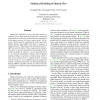128
click to vote
ICIG
2009
IEEE
14 years 10 months ago
2009
IEEE
Optical flow estimation is one of the main subjects in computer vision. Many methods developed to compute the motion fields are built using standard heuristic formulation. In this...
118
click to vote
TIP
2008
15 years 13 days ago
2008
Optical flow can be reliably estimated between areas visible in two images, but not in occlusion areas. If optical flow is needed in the whole image domain, one approach is to use ...
102
click to vote
IJCV
2006
15 years 16 days ago
2006
Subspace based factorization methods are commonly used for a variety of applications, such as 3D reconstruction, multi-body segmentation and optical flow estimation. These are usu...
101
Voted
ICPR
2000
IEEE
16 years 1 months ago
2000
IEEE
Digital Particle Image Velocimetry (DPIV) aims at flow visualisation and measurement of flow dynamics in numerous applications, including hydrodynamics, combustion processes and a...
108
Voted
ICIP
1998
IEEE
16 years 2 months ago
1998
IEEE
Optical flow estimation from image sequences has been for several years a mathematical process carried out by general purpose processors in no real time. In this work a specific a...
117
Voted
ICIP
2001
IEEE
16 years 2 months ago
2001
IEEE
Gradient-based optical flow estimation methods such as LucasKanade method work well for scenes with small displacements but fail when objects move with large displacements. Hierar...
147
click to vote
ICIP
2004
IEEE
16 years 2 months ago
2004
IEEE
Optical flow is widely in use in the field of image processing. In general, optical flow is computed from luminance images. However, optical flow based on luminance information hi...
109
Voted
ICIP
2005
IEEE
16 years 2 months ago
2005
IEEE
We present a new reliable hybrid recursive method for optical flow estimation. The method efficiently combines the advantage of discrete motion estimation and optical flow estimati...
120
Voted
ECCV
2006
Springer
16 years 2 months ago
2006
Springer
Using the variational approaches to estimate optical flow between two frames, the flow discontinuities between different motion fields are usually not distinguished even when an an...
171
click to vote
ECCV
2004
Springer
16 years 2 months ago
2004
Springer
Abstract. We study an energy functional for computing optical flow that combines three assumptions: a brightness constancy assumption, a gradient constancy assumption, and a discon...




